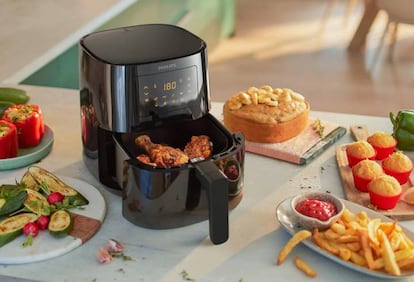Tasty, low-calorie meals at home: Is an air fryer the answer?
The appliance has taken households by storm. But is it really a healthier option, and what can you cook with it?

Croquettes, breaded steaks, churros, French fries, vegetable tempura... even some nuggets of unknown meat are an irresistible temptation for our senses. It’s frying, my friends: the miracle that makes us able to eat basically anything, as long as it has been thoroughly dipped in hot oil.
But of course, that which tastes delicious is not always great for our health. In more primitive times, foods with the most calories were the ones that appealed to us, a trick of evolution to ensure that we chose food that would be most likely to keep us alive when there were no guarantees about when we would have another occasion to eat.
Today, we live inside bodies that have not evolved at the same pace as the food environment. Unhealthy foodstuffs abound and we are easily seduced by them. So naturally, we have used technology to try and keep eating what’s delicious while reducing how bad it might be for us.
The savior of health-conscious lovers of fried food is here
The air fryer, which has now taken its place in many homes and businesses, promises to take the oil out of frying without taking away your will to live. Does it?
First of all, the air fryer is basically a convection oven, but smaller. Food is placed in a chamber and a small amount of oil added. The air is heated and circulated by a fan and the oil forms a series of droplets suspended in the air.
The combination of the air and the droplets of hot oil dehydrates the surface of the food and generates a crust with the toasted color of fried food. The texture achieved is crispy and crunchy, comparable to that of traditional frying; provided that sufficiently high air temperatures are used (between 180-200ºC).
The aroma is weaker than with fried food, though—likely because the compounds that form in frying are much less developed in air frying. At any rate, some consumers find its color, oiliness, hardness, crunchiness and appearance more palatable than regular frying: it’s all a matter of taste.
Is it nutritionally worth it?
This version of “frying” significantly reduces the amount of oil in the final product, since in conventional frying the oil represents between 30-50% of the weight of the cooked food. So, speaking in purely energetic terms, food cooked in the air fryer can provide only a third of the kilocalories found in the same fried food. You can use an oil spray to keep the fat distribution thin and even. Air frying reduces the amount of oil in the final product by up to 90% and has only a third of the calories found in conventionally fried food.
While counting calories is not the best way to manage your health, the quality of the calories does matter and they certainly have a finer constitution in air fried food. During conventional frying, fats deteriorate due to the effect of heat and substances appear that negatively affect our health (these include polar compounds which can slow metabolism, acrylamide which can weaken nerves, or acrolein which is a toxin).
Again, good news: fewer polar compounds are formed in air fryers and much less acrylamide (up to 90% less) and acrolein. Heat not only degrades the cooking fat, it also acts on the food itself, creating chemical reactions that produce toxins such as heterocyclic amines and polycyclic aromatic hydrocarbons (PAHs). In air frying, both toxins are produced in smaller quantities, another win for this nifty appliance.
If this all seems like a good idea for your health, bear in mind that, even more important than how you cook is what you cook, including what you serve it with. Put another way, air-fried bacon is still processed meat, while green asparagus are a great accompaniment, if you don’t dip them in barbecue sauce.
Croquettes and other fried foods
Here comes the catch. You will not be able to recreate all your favorite fried foods with an air fryer. Here are some that can simply only be fried in the conventional way:
- Soft, loose doughs: don’t try to make a healthy fritter. The dough will end up in parts of the fryer unknown even to the manufacturer.
- You can make croquettes, but you will have to choose: either make a bechamel sauce resembling reinforced concrete to prevent the runny dough from escaping, or cover the croquettes with a couple of layers of breadcrumbs.
- Foods that can melt, such as butter or cheese.
- Foods that weigh little, with a lot of surface area and little volume: it is an “air” fryer remember - spinach and spices will fly in it.
- Very bulky foods: although the air fryer operates like an oven, it does not have the same capacity. Don’t try to roast a chicken: the outer layers will char with the inside staying disgustingly raw.
- Tempura batter (or any runny batter that doesn’t stick together).
- Fried eggs.
Finally, do not be surprised that starchy foods like potatoes come out of the air fryer with a harder texture than when they are conventionally fried. In air frying, less gelatinization of the starch (the process which gives potato chips for example their typical consistency) occurs.
New ways with chicken wings, dehydrated veg and eggplant chips
Notably, the air fryer has some technical advantages over the oil fryer. As my fellow foodie Mónica Escudero says, most air fryers “offer a temperature range between 80 and 200 degrees.” Therefore, “you can play with the double temperature to cook wings —lower it first for a long time to make the interior tender and melt the excess fat, with a strong heat at the end for a crispy skin— or use only the low one to get a juicy and tender chicken breast or salmon”.
While you can’t fry eggs, this machine is still ideal for cooking them at a low heat - at 80 degrees for 13 to 14 minutes they’re perfect. It is also great for dehydrating fruits or vegetables. Escudero says air fryers are perfect for the types of vegetables that could only be made crispy with a lot of batter and oil, like eggplant chips and zucchini, or indeed “for roasting chopped vegetables that you can then use as a garnish for rice or pasta, in omelets or to give extra flavor to a creamed vegetable soup.”
Does it pay?
So, you’re thinking of making the leap and getting an air fryer. Here are some more facts to help you decide if it’s worth it to have one more appliance in the kitchen:
- Time: it takes longer. Don’t expect to have the food ready in five minutes because any cycle usually takes about 20-30 minutes.
- Capacity: you won’t be able to cook large quantities of food as one does in an oven, or fry a few steaks side by side. Keep this in mind when choosing the model, because they come in different sizes.
- Space: if you have a kitchen with an island (and a view of the beaches of Malibu), congratulations, you can skip this step. If you have the kitchen of an average person and have to move the fruit bowl out of the way to open the folding table, note that the air fryer takes up a lot of space.
- Smells: in a bonus point for the air fryer, the smells it creates are much less scandalous than conventional frying. You can fry sardines without the whole building knowing about it.
- Cleanliness: another point! You don’t have to clean the worktop, half the wall and the extractor hood every time you make pies and pasties.
- Home economics: you’ll save on oil, that’s for sure. And you’ll have less used oil to recycle (please tell me you recycle your oil as the environmental gods command and don’t throw it down the sink.)
- The energy cost is also lower than that of a conventional frying pan, oven or microwave.
Looks like the air fryer wins by a landslide? Before rushing out to buy one, just consider how many fried foods you eat. If you fry non-stop, there are obvious benefits here, but do take the opportunity to consider why you fry so much and what impact it has on your diet overall. If you’re thinking about giving up other culinary techniques instead of upping your consumption of raw fats or fresh vegetables, that’s the first thing you need to address.
Tu suscripción se está usando en otro dispositivo
¿Quieres añadir otro usuario a tu suscripción?
Si continúas leyendo en este dispositivo, no se podrá leer en el otro.
FlechaTu suscripción se está usando en otro dispositivo y solo puedes acceder a EL PAÍS desde un dispositivo a la vez.
Si quieres compartir tu cuenta, cambia tu suscripción a la modalidad Premium, así podrás añadir otro usuario. Cada uno accederá con su propia cuenta de email, lo que os permitirá personalizar vuestra experiencia en EL PAÍS.
¿Tienes una suscripción de empresa? Accede aquí para contratar más cuentas.
En el caso de no saber quién está usando tu cuenta, te recomendamos cambiar tu contraseña aquí.
Si decides continuar compartiendo tu cuenta, este mensaje se mostrará en tu dispositivo y en el de la otra persona que está usando tu cuenta de forma indefinida, afectando a tu experiencia de lectura. Puedes consultar aquí los términos y condiciones de la suscripción digital.
More information
Últimas noticias
Most viewed
- Oona Chaplin: ‘I told James Cameron that I was living in a treehouse and starting a permaculture project with a friend’
- Sinaloa Cartel war is taking its toll on Los Chapitos
- Reinhard Genzel, Nobel laureate in physics: ‘One-minute videos will never give you the truth’
- Why the price of coffee has skyrocketed: from Brazilian plantations to specialty coffee houses
- Silver prices are going crazy: This is what’s fueling the rally











































